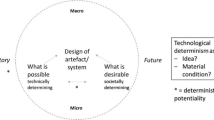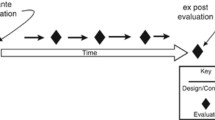Abstract
Under the rapid development of higher vocational colleges in China, design subject was receiving increasing number of students and confronting the necessity of improving teaching efficiency. Informational technology, regarded as an effective approach in many areas, was investigated for its impact on the design teaching efficiency and evaluated its potential appropriateness in this research. Under the same topic containing five different design modules, we set an informational teaching group and a traditional teaching group that they had the same number of students. Additionally, the teaching quality and effectiveness was evaluated by the combination of Information Technology-Based Interaction Analysis System, students’ anonymous questionnaire, and assessments from the teacher and industrial experts, which were considered as objected analysis, subjective responses, and professional assessment, respectively. Our findings showed that the application of informational technology could improve the teaching and learning effectiveness. Informational teaching was capable of increasing students’ interest and participation by transforming receiving knowledge passively into searching, discovering, and solving problems actively. The results of questionnaire exhibited that informational technology might effectively enhance supporting knowledge access, strengthening knowledge learning, and cultivating students’ interest. The industrial experts showed more appreciation for students’ behavior under informational teaching. When the content was mainly related to basic knowledge or sort of interdisciplinary, the advantages from informational teaching would be weakened or even disappeared. In the future, the experiment or research could be extended and upscaled for more detailed information, which might promote people’s acknowledgement in design teaching.

Similar content being viewed by others
Data Availability
The data that support the findings of this study are available from the corresponding author, Y NI, upon reasonable request.
References
Balaban, I., Bubas, G., & Pipan, M. Key elements of an e-learning course evaluation survey: An empirical validation. 14th International Conference on Interactive Collaborative Learning. IEEE, 2011: 336–343.
Croxton, R. A. (2014). The role of interactivity in student satisfaction and persistence in online learning. Journal of Online Learning and Teaching, 10(2), 314.
Darling-Hammond, L., & Bransford, J. (Eds.). (2007). Preparing teachers for a changing world: What teachers should learn and be able to do. John Wiley & Sons.
Darling-Hammond, L., Newton, X., & Wei, R. C. (2010). Evaluating teacher education outcomes: A study of the Stanford Teacher Education Programme. Journal of Education for Teaching, 36(4), 369–388.
Elshami, W., Taha, M. H., Abuzaid, M., et al. (2021). Satisfaction with online learning in the new normal: Perspective of students and faculty at medical and health sciences colleges. Medical Education Online, 26(1), 1920090.
Falco, V. P., Fedorov, V. A., Dorozhkin, E. M., et al. (2016). Forming artistic-design competency of Vocational Design teacher. International Journal of Environmental and Science Education, 11(16), 9266–9284.
Fernandes, C. E. (2022). Stream and learn’: An experiment to Reconnect Design students with theoretical contents during the pandemic. International Journal of Art & Design Education, 41(1), 50–65.
Gembarski, P. C. (2020). Good idea or bad idea?–Teaching knowledge-based engineering in a flipped classroom. Proceedings of the 22nd International Conference on Engineering and Product Design Education (E&PDE 2020), VIA Design, VIA University in Herning, Denmark. 10th-11th September 2020.
Hoppe, L. V., Kuschmitz, S., Gembarski, P. C., & DIGITAL LEARNING ENVIRONMENTS TO SUPPORT DESIGN EDUCATION. (2022). Proceedings of the 24th International Conference on Engineering and Product Design Education (E&PDE 2022), London South Bank University in London, UK. 8th-9th September 2022.
Jin, J. F., & Gu, X. Q. (2010). Analysis and research of classroom teaching behavior in information technology environment. China Educational Technology, 9, 88–92.
Jones, D., Lotz, N., & Holden, G. (2021). A longitudinal study of virtual design studio (VDS) use in STEM distance design education. International Journal of Technology and Design Education, 31(4), 839–865.
Joyce, S. (2019). Strengthening skills: expert review of Australia’s vocational education and training system.
Kim, K. G., Oertel, C., Dobricki, M., et al. (2020). Using immersive virtual reality to support designing skills in vocational education. British Journal of Educational Technology, 51(6), 2199–2213.
Kizlik, B. (2012). Measurement, assessment, and evaluation in education. Retrieved October, 10, 2015.
Kumke, M., Watschke, H., Hartogh, P., et al. (2018). Methods and tools for identifying and leveraging additive manufacturing design potentials. International Journal on Interactive Design and Manufacturing (IJIDeM), 12(2), 481–493.
Lai, Y. C., & Peng, L. H. (2019). Effective teaching and activities of excellent teachers for the sustainable development of higher design education. Sustainability, 12(1), 28.
Lawton, D., Vye, N., Bransford, J., et al. (2012). Online learning based on essential concepts and formative assessment. Journal of Engineering Education, 101(2), 244–287.
Lv, K., Sun, Z., & Xu, M. (2021). Artificial Intelligent based video analysis on the Teaching Interaction patterns in Classroom Environment. International Journal of Information and Education Technology, 11(3), 126–130.
Meyer, K. A. (2014). Student engagement in online learning: What works and why. ASHE High Educ Rep, 40(6), 1–114.
Nespoli, O. G., Hurst, A., & Gero, J. S. (2021). Exploring tutor-student interactions in a novel virtual design studio. Design Studies, 75, 101019.
Nurtanto, M., Arifin, Z., Sofyan, H., et al. (2020). Development of model for professional competency assessment (Pca) in vocational education: Study of the engine tune-up injection system assessment scheme. Journal of Technical Education and Training, 12(2), 34–45.
Rais, M. (2018). Skill Competency Test Model (UKK) Graduates of Partnership-Based Vocational High School: Preparing Graduates Facing the Fourth Industrial Revolution. Advances in Social Science, Education and Humanities Research (ASSEHR), 201: 339–343.
Rintala, H., & Nokelainen, P. (2020). Vocational education and learners’ experienced workplace curriculum. Vocations and Learning, 13(1), 113–130.
Rodriguez C, Hudson R, Niblock C (2018). Collaborative learning in architectural education: Benefits of combining conventional studio, virtual design studio and live projects. British Journal of Educational Technology, 49(3): 337-353.
Sopher, H., Fisher Gewirtzman, D., & Kalay, Y. E. (2019). Going immersive in a community of learners? Assessment of design processes in a multi-setting architecture studio. British Journal of Educational Technology, 50(5), 2109–2128.
Sun Jingsong (2017). Studio Teaching Mode of Art Design Subject of Vocational College: A Case Study of " Art Workshop” Teaching Mode of Nanjing Vocational Institute of Industry Technology.Journal of Landscape Research, 9(3).
Violante, M. G., & Vezzetti, E. (2014). Implementing a new approach for the design of an e-learning platform in engineering education. Computer Applications in Engineering Education, 22(4), 708–727.
Wagah, M. O., Indoshi, F. C., & Agak, J. O. (2009). Attitudes of teachers and students towards art and design curriculum: Implications for vocational education in Kenya. Educational Research and Review, 4(10), 448–456.
Wang, W., & Han, M. (2015). Quantitative analysis of the speech of the teachers and students in high school English classroom-based on information technology-based interaction analysis system. Theory and Practice in Language Studies, 5(10), 2107.
Wei, X., Weng, D., Liu, Y., et al. (2015). Teaching based on augmented reality for a technical creative design course. Computers & Education, 81, 221–234.
Xiong, J. (2011). Understanding higher vocational education in China: Vocationalism vs confucianism. Frontiers of Education in China, 6(4), 495–520.
Yuan, W., & Wang, Y. (2021). The Development of Vocational Education and Training in China. 1st International Conference on Education: Current Issues and Digital Technologies (ICECIDT 2021). Atlantis Press, : 375–383.
Yuan, W., Wu, Y., Zhu, C. (2022). Research on Classroom Teaching Behavior Under the Influence of Information Technology. International Conference on Adaptive and Intelligent Systems. Springer, Cham, : 485–499.
Funding
This study was supported by the Department of Education of Guangdong Province 2021WTSCX183 and 2021WQNCX170, and Guangdong Eco-Engineering Polytechnic 2022zlgc-xj-jpkc020.
Author information
Authors and Affiliations
Contributions
Yuan NI: conception and design; acquisition of data; analysis and interpretation of data; drafting the manuscript; making figures and tables.
Corresponding author
Additional information
Publisher’s Note
Springer Nature remains neutral with regard to jurisdictional claims in published maps and institutional affiliations.
Rights and permissions
Springer Nature or its licensor (e.g. a society or other partner) holds exclusive rights to this article under a publishing agreement with the author(s) or other rightsholder(s); author self-archiving of the accepted manuscript version of this article is solely governed by the terms of such publishing agreement and applicable law.
About this article
Cite this article
Ni, Y., Deng, T., Li, J. et al. Is informational teaching more efficient than traditional teaching in design? – a case study of product design in vocational education in Guangzhou. Educ Inf Technol 28, 13791–13803 (2023). https://doi.org/10.1007/s10639-023-11766-w
Received:
Accepted:
Published:
Issue Date:
DOI: https://doi.org/10.1007/s10639-023-11766-w




